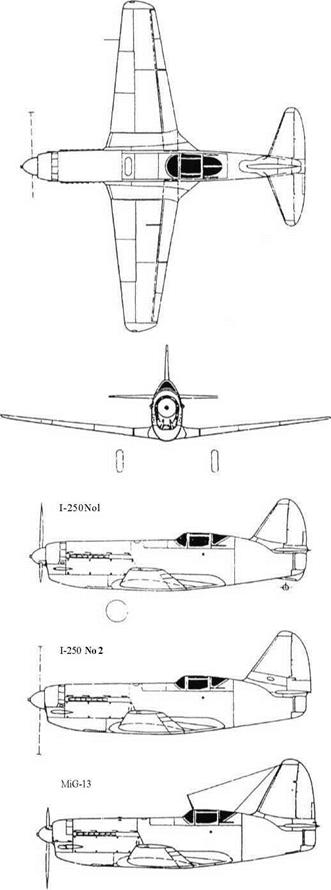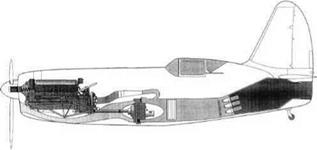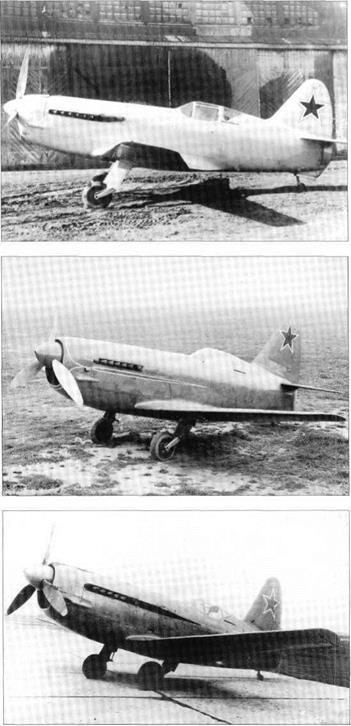MiG I-250, MiG-13
Purpose: To boost the speed of a piston – engined fighter.
Design Bureau: The OKB-155 ofAI Mikoyan.
In 1942 the Central Institute for Aviation Motors (often abbreviated as TsIAM) began to develop an unusual method of boosting the propulsive power of fighter aircraft. Called VRDK (from Russian for ‘air reaction auxiliary compressor’) it involved adding a drive from the main engine to an auxiliary compressor for a flow of air rammed in at a forward-facing inlet. The compressed air was then expelled through a combustion chamber and propulsive nozzle. This scheme was worked on by a team led by V Kh Kholshchevnikov. In January 1944 the governments of the UK and USA announced their possession of jet aircraft. In a near-panic response, the GKO (State Committee for Defence) ordered all the main Soviet fighter OKBs to build jet aircraft. Stalin criticised designers for not already having such aircraft. As the only Soviet turbojet (the Lyul’ka VRD-2) was nowhere near ready for use, MiG and Sukhoi were assigned the urgent task of creating prototype fighters to use the VRDK booster system. Both quickly came to the conclusion that the VRDK method could not readily be applied to any of their existing fighters, and both designed special (quite small) fighters to investigate it. The MiG aircraft was called N by the OKB, and given the official designation I-250. The project was assigned to G Ye Lozino-Lozinskii. A mock-up was approved on 26th October
1944, and after frantic effort the ‘N’ Nol was rolled out painted white on 26th February
1945. OKB pilot A P Dyeyev began the flight – test programme on 3rd March. Soon the magic 800km/h mark was exceeded, and Mikoyan presented Dyeyev with a car. VRDK operation was generally satisfactory but deafeningly noisy. On 19th May a tailplane failed at low level and the ‘N’ Nol crashed. By this time ‘N’ No2 was almost ready to fly. Painted dark blue, with a yellow nose and horizontal streak, it was restricted to 800km/h to avoid a repetition ofthe failure. Stalin had meanwhile ordered that a ‘regiment’ of ten of these aircraft should fly over Red Square on 7th November, October Revolution Day. ‘N’ No 2 was tested by LII pilot A P Yakimov, assisted by OKB pilot A N Chernoburov. This aircraft was written off in a forced landing in 1946. The hastily built ten further I-250s were tested by IT Ivashchenko. On 7th November nine were ready, but the flypast was cancelled because of bad weather. In late 1946 Factory No 381 was given an order for 16 fully equipped fighter versions, designated MiG – 13. Factory testing of these took place in May-
July 1947,1 M Sukhomlin carried out NIl-WS testing between 9th October 1947 and 8th April 1948, and these aircraft were then delivered to the A V-MF. They served with the Baltic and Northern Fleets until 1950.
Aircraft N bore little similarity to any previous MiG design. Made entirely of metal, with a stressed-skin covering, it was smaller than most fighters, whereas its predecessors had been larger. The straight-tapered wing had a CAHI 10%-thick laminar aerofoil, with two spars and plate ribs. Movable surfaces comprised two-part Frise ailerons and hydraulically operated CAHI slotted flaps. The fuselage was relatively deep to accommodate the unique propulsion system. The engine was a VK-107, rated at l,650hp for take-off and l,450hp at 3,500m (12,470ft). At the front it was geared down to drive the AV-5B three – blade constant-speed propeller of 3.1m (10ft 2in) diameter. At the back it drove the engine’s own internal supercharger as well as a clutch which, when engaged, drove through 13:21 step-up gears to a single-stage axial compressor. This pumped air through a large duct from a nose inlet. Just behind the compressor was the engine’s cooling radiator. Behind this were seven nozzles from which, when the auxiliary compressor was engaged, fuel from the main tanks was sprayed and ignited by sparking plugs. The resulting flame filled the large combustion chamber, from which a high-velocity jet escaped through a two-position nozzle. Downstream of the burners the entire duct was refractory steel, and when the VRDK was in operation its walls were cooled by water sprayed from a 78 litre (17 Imperial gallon) tank, the steam adding to the thrust. At 7,000m (22,966ft) the VRDK was estimated to add l,350hp, to a total of 2,500hp. The oil cooler surrounded the propeller gearbox, with flow controlled by gills round the top of the nose. The engine was mounted on a steel-tube truss. Fuel was housed in three self-sealing tanks, one of 415 litres (91.3 Imperial gallons) in the fuselage and one of 100 litres (22.0 Imperial gallons) in each wing. The large central tank forced the cockpit to be near the tail, with a sliding canopy. The metal-skinned tail was repeatedly modified, the small elevators having a tab on the left side. A unique feature of the main landing gear was that the wheels were carried on single levered-suspension arms projecting forward from the leg. The tail – wheel was fully retractable. Even the first aircraft, called ‘N’ Nol, was fully armed with three B-20 cannon, each with 160 rounds. The MiG-13 batch differed in having a larger vertical tail, larger fuel and water tanks, RSI-4 radio with a wire antenna from the fin to a mast projecting forwards from the windscreen, and (temporarily) strange curved propeller blades in an attempt to reduce tip Mach number.
These aircraft performed as expected, but were a dead-end attempt to wring the last bit of performance from piston-engined fighters.
|
Dimensions (I-250) Span Length Wing area |
9.5m 8.185m 15.0m2 |
31 ft 2 in 26 ft 1 OX in 161 ft2 |
|
Weights |
||
|
Empty |
2,935kg |
6,470.5 Ib |
|
Fuel/oil/water |
450/80/75 kg |
992/176/165 Ib |
|
Loaded |
3,680 kg |
8,1131b |
|
Performance |
||
|
Max speed at sea level |
620km/h |
385 mph |
|
at 7,000 m (22,966 ft) |
825 km/h |
513 mph |
|
Time to climb to 5,000 m |
3.9 min |
(16,404ft) |
|
Service ceiling |
11,960m |
39,240ft |
|
(without VRDK) |
10,500m |
34,450 ft |
|
Range (with briefVRDK) |
920km |
572 miles |
|
(no VRDK) |
1,380km |
858 miles |
|
Take-off speed/ |
200 km/h |
124 mph |
|
run |
400m |
1,312ft |
|
Landing speed/ |
150 km/h |
93 mph |
|
run |
515m |
1,690ft |
|
Dimensions (MiG – 13) |
||
|
Span |
9.5m |
31 ft 2 in |
|
Length |
8.185m |
26ftlOXin |
|
Wing area |
15.0m2 |
161 ft2 |
|
Weights |
||
|
Empty |
3,028kg |
6,675 Ib |
|
Fuel/oil/water |
590/80/78kg |
1,301/1 76/172 Ib |
|
Loaded |
3,931 kg |
8,666 Ib |
|
Performance |
||
|
Max speed at sea level |
620 km/h |
385 mph |
|
at 7,000m (22,966 ft) |
825 km/h |
513 mph |
|
Time to climb to 5,000 m |
3.9 min |
(16,404 ft) |
|
Service ceiling |
11,960m |
39,240 ft |
|
without VRDK |
10,500m |
34,450ft |
|
Range (with brief VRDK) |
1,818km |
1,130 miles |
|
(no VRDK) |
1,380km |
858 miles |
|
Take-off speed/ |
200 km/h |
124 mph |
|
run |
400m |
1,312ft |
|
Landing speed/ |
195 km/h |
121 mph |
|
run |
515m |
1,690ft |
Photographs on the opposite page:
Top: I-250 Nol.
Centre: I-250 No 2.
Bottom: Production MiG-13 (straight propeller blades).
|
|
||













